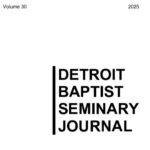Divorcing the Person from the Work of Christ?
Last week I read a curious piece that purported to identify the exact point at which Pilgrim was saved in John Bunyan’s Pilgrim’s Progress: was it at the wicket gate, at the foot of the cross, or perhaps even at some other point? I confess a measure of confusion on the matter. Like many before me, I’ve had the uneasy sense that the salvation event in Bunyan’s little tome is more a process than a point.
As uneasy as I have been with Bunyan’s allegory on this matter, I am more uneasy still with the explanation offered by Jim Orrick in his blog post. In Orrick’s understanding, Pilgrim is justified when he goes through the narrow wicket gate (i.e., he believes Christ and loses his forensic guilt), and then is relieved of his psychological guilt when he arrives at the foot of the cross and grasps the theological significance of what occurred there. Had Orrick stopped here, I might have been amenable to his theory.
Instead, Orrick goes on to support his theory with the emphatic statement that “the Bible proclaims that a person gets saved when he receives Christ, and the Bible does not say that a person gets saved through believing that Jesus died for him. Christ himself is the proper object of saving faith, not some part of his work.” He adds, “A person is saved not when he believes in right doctrine…but when he believes in the right person, namely Christ. So the object of saving faith is not a doctrine but a person.”
I find this troubling on multiple levels. Firstly, the Scriptures demand more than a mere reception of Christ. They demand that we affirm (1) certain theological facts about Christ’s person—he is Lord (Rom 10:13); he is God’s Son (1 John 5:1, 5); etc.—and (2) certain theological facts about his work—he died (1 Thess 4:14); he rose again (Rom 10:13); he will judge/reward (Heb 11:6); etc. Granted, we don’t have to know every theological nuance about atonement in order to be saved, but there are some basic facts that are non-negotiable: that Christ died for our sins according to the Scriptures, that he was buried, and that he was raised on the third day according to the Scriptures (1 Cor 15:3–4).
But secondly (and more importantly), I am troubled about the theological implications of divorcing faith in Christ’s person from faith in Christ’s work. If indeed an individual can “receive Christ” for true salvation without affirming even the most rudimentary details about what Christ did, then soteriology is effectively stripped of all but an existential Christ encounter: all else becomes optional. This door has been taken many times in the history of the church, and never to a good end. Let us hope that Orrick’s post is not opening up this door yet again.



I find that I agree with both your concern and what I understand to be Justin’s concern.
On the one hand we are not preserving the Gospel if what we preach is an existential encounter with “Christ” devoid of doctrinal content. I’m sure Justin would agree with that.
But I think the contrary error against which Justin is reacting is what gives birth to what I call in my book the “Gutless Grace” error. It’s the idea that you can extract a doctrine or two, affirm them, and your Eternal Fire Insurance policy kicks in. Then when such a person shows not the least sign of Christ in his life, we’re told that all’s well, because he believed Jesus died for him. He’s just a “carnal Christian.” Assure him of salvation, pray for him, and leave him be.
The solution is, of course, preaching Christ — all of Him. Salvation comes to the one who confesses Jesus as Lord. And I would follow up by arguing that confession of Jesus as Lord will lead to affirmation of ALL the doctrines of Scripture, including penal, substitutionary atonement and forensic justification.
Forgive an inadequate analogy. Imagine a course in Systematic Theology. Imagine that I say I want to sit in on the classes dealing with theories of the atonement. Could I be said to have taken the class?
If, however, I sign up for the class, per se, then I will be there (DV) for the classes on atonement — and all the others.
Hope this is of some help.
Dan,
I think we agree. A bare affirmation of the rudiments of Christ’s atoning work is inadequate and a bare reception of Christ is inadequate. Both are necessary. True faith demands both a person and a proposition. They can’t be divorced.
Granted, we don’t want to “front load” the Gospel such that we require the appropriation and embrace of an entire ecclesiastical confession before we acknowledge genuine faith in a new convert, but there is an irreducible minimum of doctrine that necessarily attends the personal object of saving faith. The embrace of Christ apart from any specific knowledge about who he is and what he has done is not enough.
MAS
Mark, I led our church through a study of Pilgrim’s Progress a few years ago and noticed the same issue.
Perhaps it would be helpful to remember that Bunyan wasn’t adding another book to the canon, though his work is profitable.
I think the issue comes in trying to display in allegorical form all the experiences of the Christian life. There are other points in the allegory that similarly distort the actual progress of a Christian life, partly by including other believers in the story with Christian.
In this case, he is describing two aspects of the saving experience and has imagined them in two different scenarios. Actually, as I recall, I think that one could add his initial response to the Evangelist’s call as a third “saving experience”. The whole thing is not meant to be a picture of the Christian life as it is from start to finish, but aspects of the Christian experience considered under different images.
FWIW
Maranatha!
Don Johnson
Jer 33.3